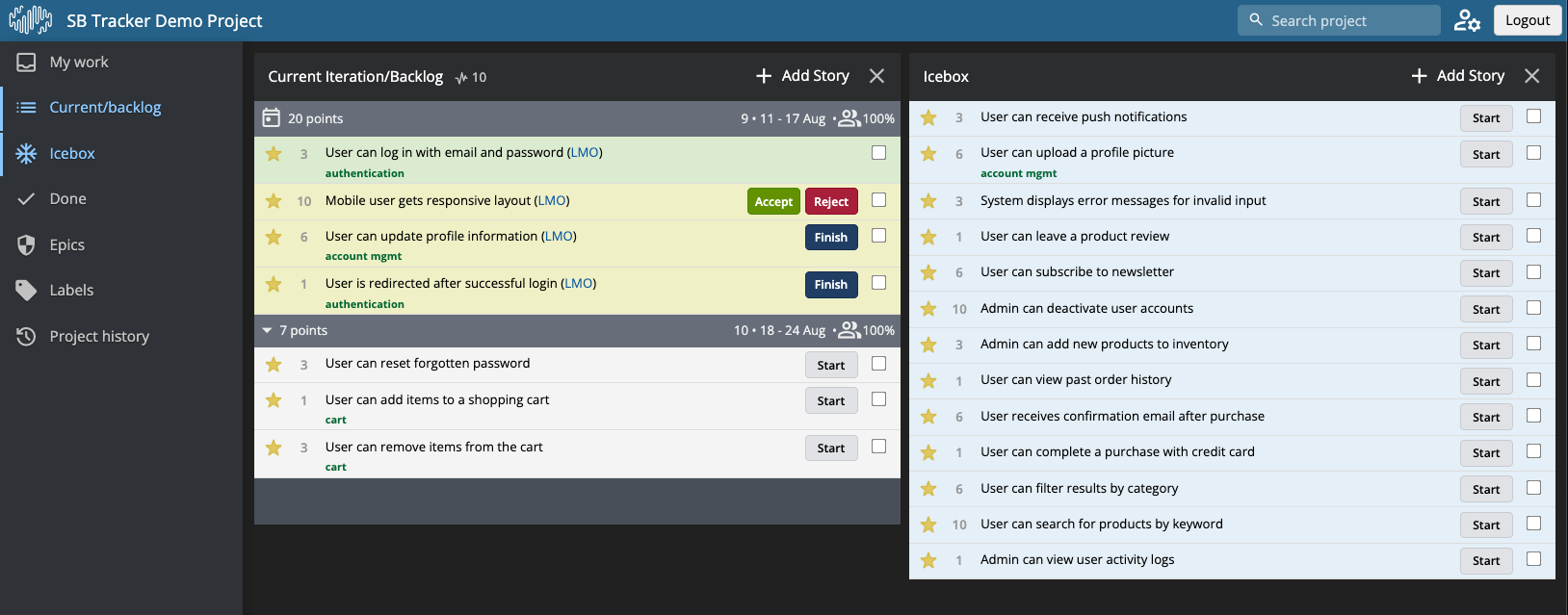Summary
When our favorite PM software was being shut down, we built a work-alike replacement that we’re happily using every day. Here’s what it looks like:

The Problem
We used Pivotal Tracker (PT) as our project management software for many years. It was a simple, fast, SaaS platform that we used to collaborate with our clients. It was an Agile-style tool, with user stories (features, bugs, etc) organized into weekly iterations. It helped with project planning by automatically calculating development velocity and telling us which stories would be done at what time. Its model matched our development style perfectly, and its comprehensive API and webhook system enabled us to integrate other software with it.
Unfortunately for us, Pivotal (including Tracker) was bought by VMWare in 2019, and VMWare was subsequently acquired by Broadcom in 2023. After several announcements about the future of PT being uncertain, it becoming an enterprise-only offering, etc, the newest owners finally announced in September 2024 that Pivotal Tracker was being completed terminated in April 2025, and we were left with a big decision to make about how to replace this key piece of software that we were so reliant on. We only had seven months to transition.
Dead Ends
Open Sourcing Pivotal Tracker
We knew that Pivotal Tracker was built in Rails, and we love Rails! We contacted the PT support team to inquire about the possibility of open-sourcing their codebase so that we could adopt it and stand up our own deployment. They told us they were interested, but that they had to get approval from their corporate overlords. After four months of non-committal exchanges, they finally told us that there would be no open-source release of PT.
Third-Party PT Replacements
PT was beloved by many teams and many developers. It quickly became apparent that lots of teams were building PT replacements. These efforts even got their own roundup site. We explored several of the most promising replacements in late 2024, but didn’t find any that met our needs. We needed API compatibility with PT, a webhook system to integrate our other pieces of software, and a UI that worked really well because our standards are quite high.
Alternate Project Management Software
One obvious alternate path would be to change to another existing PM software platform. We’ve worked with many, including Jira, Trello, Monday, ClickUp, and Asana, but they’ve always felt unwieldly compared to PT’s simplicity and intentionally limited feature set. We also had to grapple with our various software integrations with PT, all of which would need to be rewritten if we switched platforms. It might have been worth it if we had another PM platform that we loved, but since there wasn’t one this was a pretty unattractive option.
Decision Time
In late December, with four months left in PT’s life, we started to prototype our own replacement software. The key challenges that we needed to solve for were:
- PT API compatibility
- PT webhook compatibility
- Real-time UI updates to enable rapid collaboration
- Emergent, automatic iteration planning to forecast future development velocity
A couple of weeks of prototyping led us to a very promising and streamlined architecture based on Rails, React, Redux Toolkit, and RTK Query. This work gave us the confidence to move forward with building our own replacement for Pivotal Tracker, even while facing a hard launch deadline only a few months away.
Implementation
Backend
We built out most of the REST-style API first in Rails before we built any of the project’s UI. Rails was a natural fit for the backend because the PT API design that we were targeting was designed in a very idiomatic Rails style. We wrote automated tests to make sure our code was working correctly, and we pointed some of our other PT-integrated software at our new API to ensure that we were making it a PT API-compatible.
Frontend
Visually, PT was cleanly designed and its UI had held up without any major revisions over the years. We reduced the need for decision-making (and user re-training) by building SB Tracker as a close facsimile of PT.
React was a natural fit for this single-page app, allowing us to organize our code into clean and reusable components. Redux Toolkit and its fantastic RTK Query data framework made our data fetching, caching, and persistence really easy. RTK Query paired perfectly with the Rails API, and also let us code optimistic updates to make our UI feel very responsive. RTK Query’s built-in cache invalidation strategies are absolutely first class, and make it possible to solve a famously hard problem with relative ease.
Moving Quickly
We minimized our overall development work in a few ways.
- Our PT-compatible REST API, which makes it possible to integrate our other software platforms, also serves as the backend for the UI.
- The event notification system which powers our webhooks is also used to provide real-time UI updates.
- The frontend is built in Typescript, which is a huge improvement over regular Javascript. Its type system prevents many bugs and enables helpful code autocompletion.
Launch
We exported all of our PT projects in early April 2025, a few weeks ahead of the deadline. We used our import tool to load them into SB Tracker, retaining all of our stories, statuses, comments, and attachments. We archived the projects in PT, notified our customers of the change, and the launch was incredibly smooth.
So far, SB Tracker is a tool for our own usage with our customers. We may eventually release it to the public, but for now we’re only just starting to allow some outside folks to use it as a closed beta. If you’re interested in a demo account and potentially a paid subscription, please get in touch.